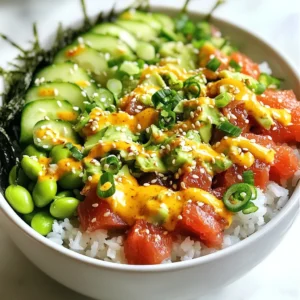
Spicy Tuna Sushi Bowls
A delicious and vibrant sushi bowl featuring spicy tuna, fresh vegetables, and sushi rice.
Ingredients
- 1 cup sushi rice
- 1.25 cups water
- 1 tablespoon rice vinegar
- 1 tablespoon sugar
- 0.5 teaspoon salt
- 200 g fresh sushi-grade tuna, diced
- 1 tablespoon mayonnaise (preferably Kewpie)
- 1 teaspoon sriracha (adjust to taste)
- 1 tablespoon soy sauce
- 1 small cucumber, thinly sliced
- 1 small avocado, sliced
- 0.25 cup edamame beans (shelled)
- 1 teaspoon sesame seeds (for garnish)
- 1 green onion chopped (for garnish)
- as needed sheets Seaweed sheets (nori), cut into strips (optional)
Instructions
- Rinse the sushi rice under cold water until the water runs clear, then drain well.
- In a medium saucepan, combine the rinsed rice and water. Bring the mixture to a boil over medium heat.
- Once boiling, cover the saucepan and reduce the heat to low. Cook for 18-20 minutes or until the rice is tender and water is absorbed.
- While the rice is cooking, prepare the sushi vinegar mixture by combining rice vinegar, sugar, and salt in a small bowl. Microwave for about 30 seconds or until sugar dissolves.
- Once the rice is cooked, transfer it to a large bowl and gently fold in the sushi vinegar. Allow it to cool at room temperature.
- In another bowl, combine the diced tuna, mayonnaise, sriracha, and soy sauce. Mix well until the tuna is evenly coated. Set aside.
- To assemble the bowls, divide the sushi rice among serving bowls.
- Top each bowl with the spicy tuna mixture, sliced cucumber, avocado, and edamame beans.
- Garnish with sesame seeds and chopped green onions. Add seaweed strips if desired.
Notes
Arrange the toppings artfully over the rice to create a colorful display. Serve with extra sriracha on the side for those who like it spicier!